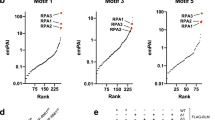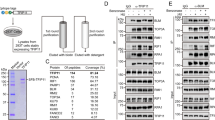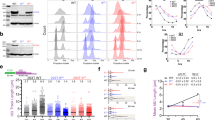Abstract
Mutations in BLM give rise to Bloom's syndrome, a genetic disorder associated with cancer predisposition and chromosomal instability. Using a dual-labeling system in isolated chromosome fibers, we show that the BLM protein is required for two aspects of the cellular response to replicative stress: efficient replication-fork restart and suppression of new origin firing. These functions require the helicase activity of BLM and the Thr99 residue targeted by stress-activated kinases.
This is a preview of subscription content, access via your institution
Access options
Subscribe to this journal
Receive 12 print issues and online access
$189.00 per year
only $15.75 per issue
Buy this article
- Purchase on Springer Link
- Instant access to full article PDF
Prices may be subject to local taxes which are calculated during checkout


Similar content being viewed by others
References
German, J. Medicine 72, 393–406 (1993).
Wu, L. & Hickson, I.D. Nature 426, 870–874 (2003).
Lonn, U., Lonn, S., Nylen, U., Winbald, G. & German, J. Cancer Res. 50, 3141–3145 (1990).
Sengupta, S. et al. EMBO J. 22, 1210–1222 (2003).
Davies, S.L., North, P.S., Dart, A., Lakin, N.D. & Hickson, I.D. Mol. Cell. Biol. 24, 1279–1291 (2004).
Wu, L. & Hickson, I.D. Annu. Rev. Genet. 40, 279–306 (2006).
Ahmad, F. & Stewart, E. Mol. Genet. Genomics 273, 102–114 (2005).
Bjergbaek, L., Cobb, J.A., Tsai-Pflugfelder, M. & Gasser, S.M. EMBO J. 24, 405–417 (2005).
Lo, Y.C. et al. Mol. Cell. Biol. 26, 4086–4094 (2006).
Neff, N.F. et al. Mol. Biol. Cell 10, 665–676 (1999).
Beamish, H. et al. J. Biol. Chem. 277, 30515–30523 (2002).
Payton, M. et al. Cancer Res. 66, 4299–4308 (2006).
Ralf, C., Hickson, I.D. & Wu, L. J. Biol. Chem. 281, 22839–22846 (2006).
Cox, M.M. Annu. Rev. Genet. 35, 53–82 (2001).
McGlynn, P. & Lloyd, R.G. Nat. Rev. Mol. Cell Biol. 3, 859–870 (2002).
Acknowledgements
We thank members of the CR-UK Genome Integrity Group for helpful discussions, N. Ellis (University of Chicago), and M. Sanz and J. German (Cornell University Medical School, New York) for the wild-type BLM- and BLM-K695T–expressing GM08505 cells, P. McHugh, K. Hanada, C. Bachrati and L. Wu for useful comments on the manuscript, and P. White for preparation of the manuscript. This work was supported by Cancer Research UK.
Author information
Authors and Affiliations
Contributions
Experiments were designed by S.L.D., P.S.N. and I.D.H., and performed by S.L.D. and P.S.N. S.L.D. and I.D.H. interpreted data and wrote the manuscript.
Corresponding author
Ethics declarations
Competing interests
The authors declare no competing financial interests.
Supplementary information
Supplementary Fig. 1
BS cells are hypersensitive to drugs that inhibit DNA replication. (PDF 59 kb)
Supplementary Fig. 2
BLM is required for efficient replication-fork restart following replication blockade. (PDF 61 kb)
Supplementary Fig. 3
The active site lysine (Lys695) and the Thr99 target site for ATR are required for cell survival after replication blockade. (PDF 36 kb)
Supplementary Fig. 4
Expression of BLM proteins in transfectred BS cells. (PDF 114 kb)
Supplementary Fig. 5
The active site of BLM is required fro suppression of new origin firing. (PDF 27 kb)
Rights and permissions
About this article
Cite this article
Davies, S., North, P. & Hickson, I. Role for BLM in replication-fork restart and suppression of origin firing after replicative stress. Nat Struct Mol Biol 14, 677–679 (2007). https://doi.org/10.1038/nsmb1267
Received:
Accepted:
Published:
Issue Date:
DOI: https://doi.org/10.1038/nsmb1267
This article is cited by
-
Targeting ATR in patients with cancer
Nature Reviews Clinical Oncology (2024)
-
RETSAT associates with DDX39B to promote fork restarting and resistance to gemcitabine based chemotherapy in pancreatic ductal adenocarcinoma
Journal of Experimental & Clinical Cancer Research (2022)
-
HERC2 inactivation abrogates nucleolar localization of RecQ helicases BLM and WRN
Scientific Reports (2021)
-
Maintaining genomic stability in pluripotent stem cells
Genome Instability & Disease (2020)
-
Chromosome instability syndromes
Nature Reviews Disease Primers (2019)



